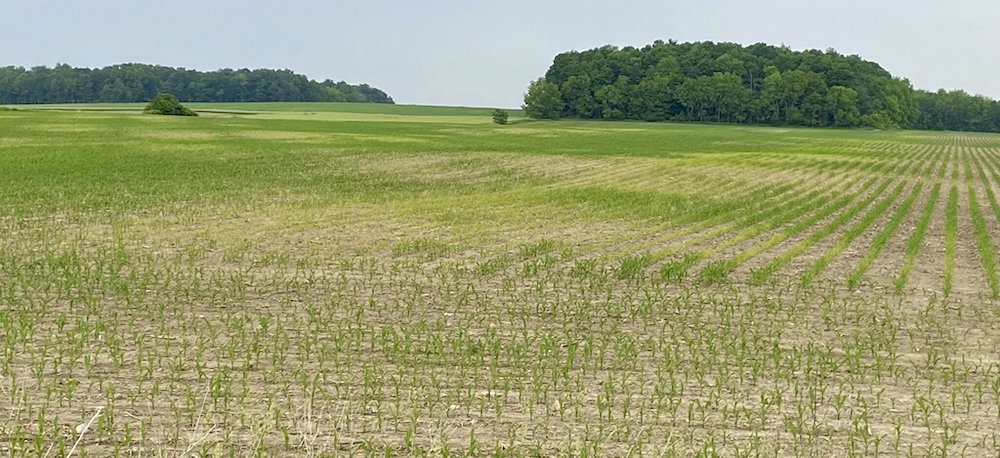Spring planting challenges continue for Ontario growers

The 2024 planting season will become the new bookmark for comparing challenging spring conditions for planting. Heavy-textured soils combined with frequent rainfall have resulted in significant acres intended for corn (up to 15 per cent) being transitioned to soybeans. In fields where herbicides and nitrogen have already been applied, options are more limited. Corn silage, cover crops (such as crimson clover or buckwheat) or annual forage crops such as Sorghum Sudan Grass could be an option for unseeded acres. Unseeded acres should not be left fallow. Planting cover crops in those fields can provide weed control and soil health benefits and can help prepare a field for timely wheat planting this fall.
Read Also


‘Recovering Farmer’ shares his story of farmer mental health in new book
Glacier FarmMedia – Gerry Friesen is doing an uncomfortable thing. He’s putting both his name and internal struggles out for…
Corn
There are no issues reported with early planted corn with most advanced stands at V8. Some corn fields planted just before the heavy rains (around May 25th) are suffering slow uneven emergence, less vigour and tile-run colour variations. The crop has stalled the last week with the wet and cool conditions, but the forecasted warm weather will quickly push corn ahead. Based on pre-side dress N test results that indicate average to slightly lower soil N, largely due to prolonged wet soils, general optimal N rates will range from normal to slightly higher. Side-dress nitrogen applications are underway.
Soybeans
The earliest planted beans are at V2-V3 stage and look great, with even emergence and uniform stand. Some fields planted just before May 25th weekend rains are suffering slow, uneven emergence and lack of vigour due to cool temperatures and some crusting. Continued wet weather has mostly helped prevent hard crust on surface, allowing some to continue to emerge. Populations in general are sufficient except for some fields that were planted at reduced seeding rates. Some emergence in these fields has been impacted by the reduced rates.
Unseeded acres are present in all geographies, dependent on soil texture and drainage. In areas with heavy clays, there are farms with no crops planted yet this spring. Slug feeding is common, especially in no-till fields, but forecasted warmer temperatures should help move them further into the soil.
Growers are encouraged to monitor fields for emergence issues and make replant decisions based on the population, insect damage and time.
Wheat
Wheat continues to look great. Fields are starting to turn colour as they reach maturity in the southwest while eastern regions of the province are completing flowering, and most acres have received the T3 fungicide applications in a timely manner. Weather conditions to date have been ideal for grain fill. Wheat heads are large with seed counts indicating 40-50 seeds per head in some fields compared to normal 32 to 35 seeds/head.
Canola
Spring canola is near bolting in some regions. A few different species of cutworm have been damaging crops in parts of Northern Ontario, including causing defoliation in canola prior to bolting. There are no clear defoliation thresholds for canola at this stage, as most studies have been on flea beetle damage in seedling stages. Generally, crops can tolerate some defoliation and concern increases above 30 per cent defoliation. Accurate identification of the cutworm will guide management decisions, as some have multiple generations and will feed on stems and pods while and others will stop feeding by the end of June. Flea beetle pressure has been high on some select fields but have not been a widespread problem in Northern Ontario.
Winter canola harvest may begin before the end of June in southern regions. Grain must be delivered at 10 per cent moisture or below. On a hot day moisture will drop by 2 or 3 per cent through the day so harvest can often begin before grain is at 10 per cent moisture. Green weeds in the field can increase harvest losses. Common pre-harvest herbicide options include Reglone and glyphosate tank-mixed with Eragon. Ensure the appropriate surfactant is included. Reglone uptake by plants is best when sprayed in the evening or on a cloudy day. Eragon works best when sprayed on a warm, sunny day.
Dry Beans
More than half of the dry bean crop has been planted and planting will be complete within the next week if it does not rain. The ideal temperature for emergence is above 15 C, and recent cool weather may have resulted in poor emergence and weakened plants.
Forages
Dairy first cut is wrapping up, and first cut on other farms is starting. Yields have been excellent, and regrowth is coming back quickly. Quality will depend on stage of crop at harvest, but with frequent rains, some fields were harvested more mature than intended. Some fields endured significant compaction and rutting during harvest.
Some stands of new seeding continue to experience potato leafhopper pressure, with some fields above threshold populations. If stands are not nearing cutting, an insecticide application may be warranted. Spring cereal forage harvest will begin shortly as much of it is at or near flag leaf.
Insects and Diseases
Cutworms are a problem in many fields, especially in Northern Ontario, where cut plants and plant feeding are showing up in patches or larger portions of fields. Of the 30 species, there are several that cause damage. Dingy cutworm overwinter as larvae and climb plants to foliar feed but rarely cut the plants; these should be completing their feeding in the next week or so. Variegated cutworm are also climbing cutworms that cause foliar feeding damage. These have a second generation that can result in foliage, bud and flower damage in canola in late July or August. Black cutworm, dark sided and redback cutworm species tend to clip plants at the soil surface. Cutworms are nocturnal, so scouting and spraying are most effective in late afternoon or early evening. Some natural predators such as ground beetles, Copidosoma parasitoids and fungal pathogens are helping to control cutworm populations. Information on cutworms, damage and thresholds can be found on Field Crop News: Cutworms of All Kinds.
Armyworm is present in some fields in Southern Ontario although as crops mature, generally they become less of a risk. Scouting for true armyworm should continue in winter cereals for the next few weeks and spring cereals for the next month. Cereal leaf beetle numbers are declining in the southwest, as they move farther north.
Tar spot has been detected in Indiana 3 weeks earlier than normal. Scouting for tar spot is important but a need for fungicide application ahead of tasselling is not anticipated for Ontario corn at this point.
Weeds
Limited opportunities for herbicide application due to wind and rain have left a high density of weeds in some fields. Fields with burndowns applied a month ago may need another application. Dicamba injury has been noted on some varieties with lower tolerance, combined with stresses including shallow seeding, heavy rain after application and cool conditions. Herbicide uptake is higher than usual with cool nights, slower growth and rain events keeping herbicides in solution, resulting in better weed control, but also higher risk of crop injury.
Agricorp Upcoming Deadlines
For Production Insurance coverage, crop planting deadlines are June 15 for corn, and June 30 for soybeans. Agricorp asks customers to contact us by June 15 if they think they will have unseeded acreage. The deadline for reporting actual acres of spring-seeded grains and oilseeds or new forages is June 30th. The unseeded acreage coverage provides one-third of a farm’s average farm yield if a crop is not planted by the planting deadline. Growers are encouraged to report acres as soon as possible to avoid busy times at the deadline.
Reporting can be done online or by calling the Guelph office (+1 888-247-4999).
– To read the full Ontario Crop Report for June 13, visit the Field Crop News website.
Source: Farmtario.com

